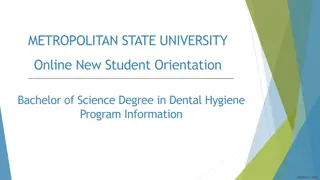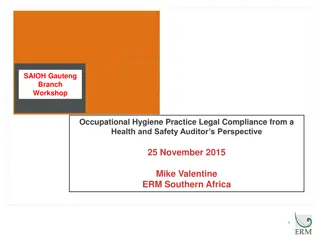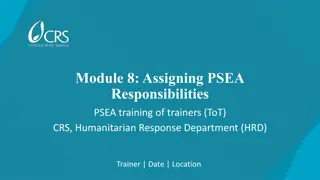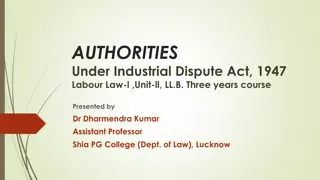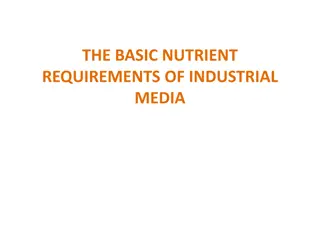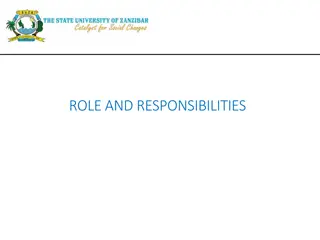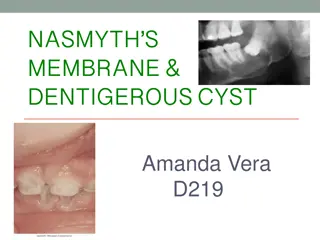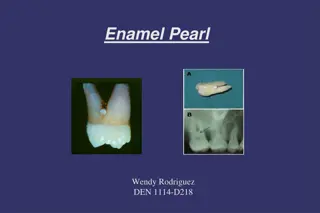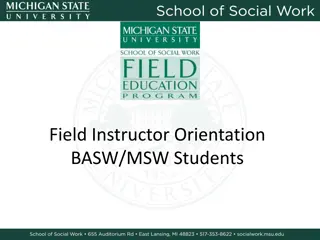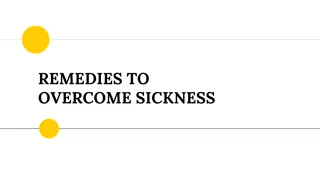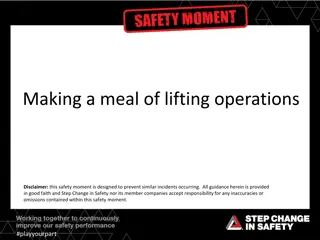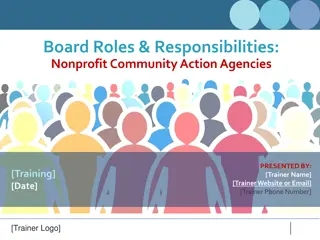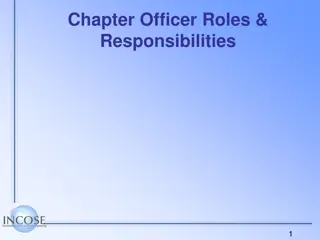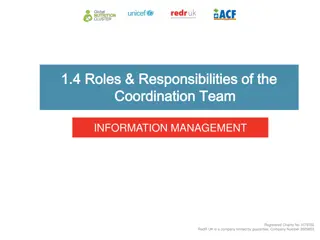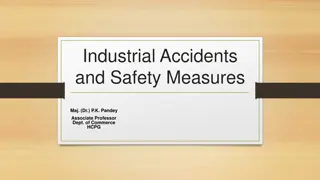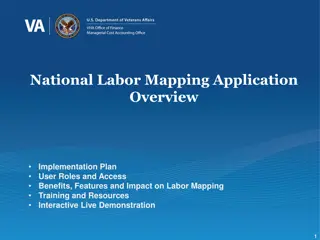Roles and Responsibilities of Industrial Hygienists
Industrial hygienists are dedicated professionals tasked with safeguarding the health of individuals in the workplace and community. They possess expertise in various scientific disciplines and play a crucial role in identifying, evaluating, and controlling environmental factors that could pose health risks. Through investigations, research, education, and collaboration with authorities, industrial hygienists ensure compliance with health and safety regulations, striving to maintain the well-being of workers and the public.
Download Presentation

Please find below an Image/Link to download the presentation.
The content on the website is provided AS IS for your information and personal use only. It may not be sold, licensed, or shared on other websites without obtaining consent from the author. Download presentation by click this link. If you encounter any issues during the download, it is possible that the publisher has removed the file from their server.
E N D
Presentation Transcript
Fundamentals of Industrial Hygiene 6thEdition Part VI: Occupational Health and Safety Professions Chapter 24: Industrial Hygienist Compiled by Janvier Gasana Associate Professor, Environmental & Occupational Health Florida International University
Introduction Industrial hygienists: Are scientists, engineers, and public health professionals committed to protecting the health of people in the workplace and the community. Must be competent in a variety of scientific fields principally chemistry, engineering, physics, toxicology, and biology as well as the fundamentals of occupational medicine. Trained initially in one of these fields, most industrial hygienists acquire knowledge of the other allied disciplines by experience and postgraduate study.
Definition of Industrial Hygiene American Industrial Hygiene Association s (AIHA) definition The science and art devoted to the anticipation, recognition, evaluation, and control of those environmental factors that may cause sickness, impaired health and well-being, or significant discomfort among workers or among citizens of the community. Industrial hygienist s goal To keep workers, their families, and the community healthy and safe. Industrial hygienists play a vital part in ensuring that federal, state, and local laws and regulations are followed in the work environment.
Typical Roles Investigate and examine the workplace for hazards and potential dangers. Conduct scientific research to provide data on possible harmful conditions in the workplace. Train and educate the community about job-related risks. Advise government officials and participate in the development of regulations to ensure the health and safety of workers and their families. Ensure that workers are properly following health and safety procedures.
Typical Roles (cont.) Many specialize in specific subdisciplines such as: toxicology, epidemiology, chemistry, ergonomics, acoustics, ventilation engineering, and statistics Work often overlaps with: safety professionals, health physicists, engineers, and others in the fields of air pollution, water pollution, solid waste disposal, and disaster planning
Responsibilities Direct industrial hygiene program. Examine work environment. Make appropriate measurements to determine magnitude of exposure or nuisance to workers and public. Present expert testimony before courts of law, hearing boards, workers compensation commissions, regulatory agencies, and legally appointed investigative bodies. Prepare appropriate text for labels and precautionary information for materials and products to be used by workers and the public. Conduct programs for the education of workers and the public in the prevention of occupational disease and community nuisance.
Job Descriptions Job descriptions and titles of industrial hygiene personnel are often similar to those of safety personnel. They have evolved to reflect more team-oriented, entrepreneurial, and consultative approaches to safety and health management. An entry-level employee may be called safety or health technologist or technician. employee evaluates hazards and operations using a few instruments, and investigates minor incidents involving occupational health issues
Occupational Health and Safety Technologist (OHST) Examples of OHS technologist activities: safety inspections industrial hygiene monitoring organizing and conducting health and safety training investigating and maintaining records of occupational accidents, incidents, injuries, and illnesses Candidates for OHST need: 5 years of experience in OSH activities, with those activities comprising at least 35% of job duties to pass OHST examination completion of Certification Maintenance requirements every 5 years.
Industrial Hygienist An industrial hygienist is somewhat more experienced and skilled than a technician and functions similar to a safety engineer. An industrial hygiene manager or supervisor traditionally has duties similar to those of a safety director and may manage entire IH program. Many facilities may have reduced the size of their SHE departments, and instead rely on outside contractors to provide personnel and skills necessary for various IH projects.
Industrial Hygiene Manager In an industry setting, the IH manager: supervises technical/support staff in the SHE department prepares budgets and plans is familiar with government agencies related to operation relates IH operations to research and development, production, environmental, and other departments or functions prepares appropriate reports The IH manager establishes priorities and initiates appropriate corrective action. The industrial hygienist and IH manager must both be effective communicators.
Certified Industrial Hygienist (CIH) To be a CIH, an individual must meet rigorous standards of education and experience before proving technical knowledge in comprehensive practice of IH. Exams are offered nationwide at commercial testing centers. All CIHs must actively work to maintain their certification by earning a specified number of certification maintenance points during 5-year cycle.
Training Plan for Entry-Level OSHA Industrial Hygienists Each newly hired CSHO must complete a minimum of 8 courses offered by the OSHA Training Institute (OTI) during first three years. Directorate of Training & Education is responsible for providing programs to educate and train OSHA compliance personnel in skills and knowledge required to perform their duties.
CSHO Training First three years of training include: Planning, developing, and conducting agency technical & specialized training courses and seminars 1. Conducting needs assessments and gap analyses to identify training needs for compliance personnel 2. Developing classroom and technology-enabled training products designed to support training and development of CSHOs 3. Maintaining and updating competency-based training information on OSHA Intranet to assist CSHOs in selecting OSHA Training Institute courses and other training and development opportunities that match his/her Individual Development Plans (IDPs) and other professional development needs 4.
CSHO Training (cont.) Maintaining and updating technology-enabled OTI course catalog on OSHA Intranet 5. Conducting evaluations of training courses & programs designed for compliance personnel 6. Keeping CSHO s training records to reflect waived required training & time extensions for required training and alternative training for #8200 Incident Command System I-200 course 7.
Education and Training Programs Education and training programs for IH include professional school training, graduate curricula, and continuing education (short courses). Professional school curricula in IH generally culminate in Master of Science or Master of Public Health degree.
Educational Resource Centers Congress authorized creation of up to 20 ERCs in 1976 Provide continuing education to OSH professionals combine medical, IH, safety, and nursing training all centers located in universities NIOSH provides half of financial support for OSH training programs Not the same as OSHA Training Institute (OTI) education centers designated nonprofit organizations offer most frequently requested OSHA Training Institute courses for private sector and other federal agency personnel
Educational Curricula Accrediting Board of Engineering and Technology (ABET) accredits master s and bachelor s programs. Academy of Industrial Hygiene is lead organization for submitting program criteria General criteria for bachelor s programs ABET required criteria to be in terms of outcome measures instead of semester hours institutions required to evaluate and monitor students to determine if program meets objectives and students meet program requirements
Continuing Education Universities offer coursework leading to degrees or short courses on specific IH topics. Many NIOSH ERCs offer courses leading to academic degrees and short courses. Many non-profit and for-profit training organizations provide short courses National Safety Council Professional IH and safety societies Consulting firms Self-paced educational activities available on Internet, CDs, video conferencing




